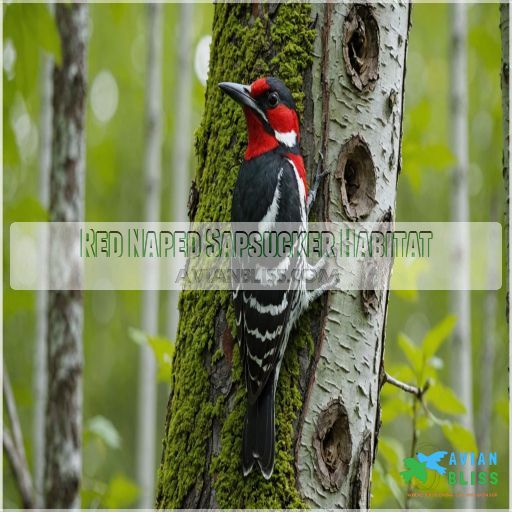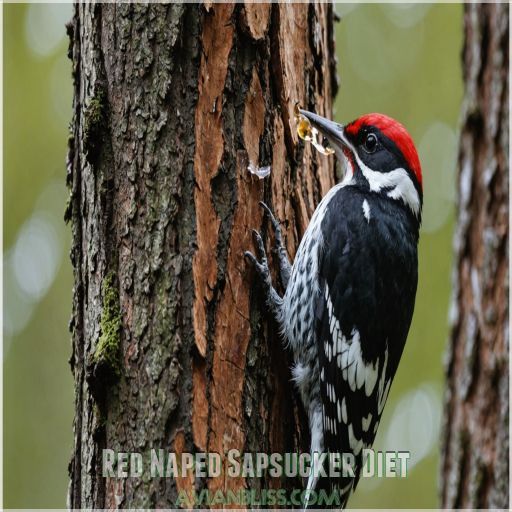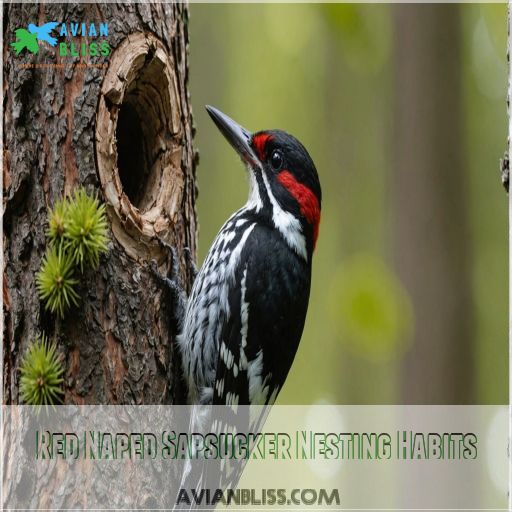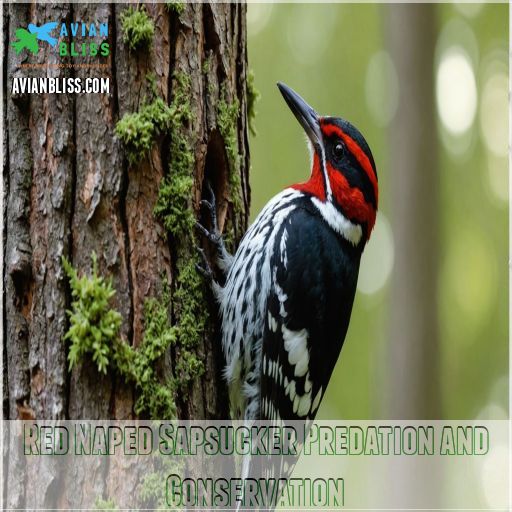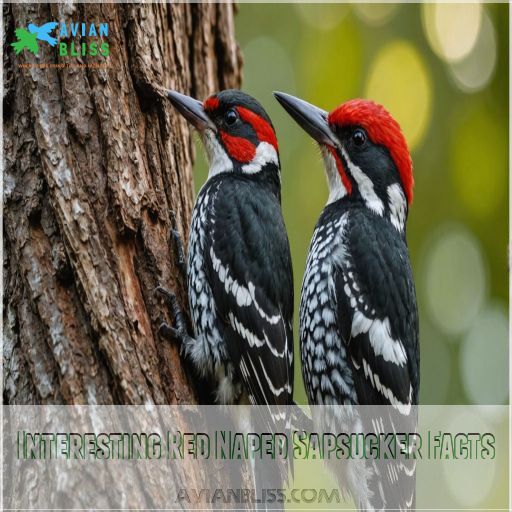This site is supported by our readers. We may earn a commission, at no cost to you, if you purchase through links.

These medium-sized birds sport a distinctive red patch on their nape and throat, with males flaunting a full red throat while females rock a white chin with a black border.
They’re tree sap connoisseurs, drilling precise wells to access their sweet treat.
You’ll find them in vibrant aspen groves and mixed woodlands from British Columbia to Arizona during breeding season, before they jet off to warmer climates for winter.
But there’s more to these feathered friends than meets the eye…
Table Of Contents
- Key Takeaways
- Red Naped Sapsucker Appearance
- Red Naped Sapsucker Habitat
- Red Naped Sapsucker Diet
- Red Naped Sapsucker Sounds
- Red Naped Sapsucker Nesting Habits
- Red Naped Sapsucker Migration Patterns
- Red Naped Sapsucker Lifespan
- Red Naped Sapsucker Vs Yellow Bellied Sapsucker
- Red Naped Sapsucker Predation and Conservation
- Interesting Red Naped Sapsucker Facts
- Frequently Asked Questions (FAQs)
- Are Red-breasted Sapsuckers rare?
- How can you tell a sapsucker from a woodpecker?
- Do Red-naped Sapsuckers migrate?
- What is the difference between Red-naped Sapsucker and yellow-bellied sapsucker?
- How do red-naped sapsuckers impact tree health?
- What methods deter sapsuckers from damaging ornamental trees?
- How do young sapsuckers learn to drill sap wells?
- Do other animals take advantage of sapsucker feeding holes?
- How widespread is the red-naped sapsucker population currently?
- Conclusion
Key Takeaways
- Get ready to meet the red-naped sapsucker, a skilled sugar seeker and part-time exterminator! With their crimson nape, they strut around vibrant forests from Canada to Mexico, staying cozy in warm spots when winter rolls in.
- These feathery architects are nature’s engineers, drilling sap wells not just for themselves, but creating a buffet for other critters too. They’ve got tongues tipped for sap slurping and a knack for snagging insects, making them the ultimate multitaskers.
- Home life for these sapsuckers is a family affair, with both parents chipping in to carve out nesting spots and feed the kiddos. They even stick around to make sure the young ones know how to drill—it’s like a parental workshop with chirps and pecks.
- The red-naped sapsucker isn’t just a pretty face; it’s a keystone species playing a big role in the ecosystem. By ensuring their survival through conservation efforts, we’re also supporting a wide community of plants and animals that depend on their diligent work.
Red Naped Sapsucker Appearance
Ever wondered what makes the Red-naped Sapsucker such a standout in the avian world?
From their eye-catching crimson nape to differences in markings between males, females, and juveniles, these woodpeckers offer a fascinating glimpse into nature’s palette.
Physical Characteristics
The red-naped sapsucker is a striking medium-sized woodpecker, with a solid white wing patch and a long, sturdy bill perfect for drilling sap wells.
Color Patterns and Markings
Spotting a Red-naped Sapsucker isn’t just a walk in the park.
Their striking plumage features red on the nape and throat, bordered by black and white markings, contrasting beautifully against Douglas fir and quivering aspen .
Differences Between Males and Females
Admiring Red-naped Sapsuckers? Look closely!
While both sexes flaunt a red crown, males boast an unabated red throat.
Females sport a white chin and black border, offering a subtle clue in rocky mountains and great lakes habitats .
Juvenile Characteristics
Witnessing the evolution of a Red-naped Sapsucker’s juvenile plumage is pure magic.
You’ll notice hints of red on their crown as they molt, revealing growth stages.
Young bird diet and nestling behavior thrive under parent care .
Red Naped Sapsucker Habitat
You’ll find red-naped sapsuckers in vibrant aspen groves and mixed woodlands, bustling about their breeding grounds from British Columbia to Arizona.
When winter hits, these savvy travelers head southward, preferring the warmer climates of southern California to Mexico, proving that even birds appreciate a sunny getaway!
Breeding Grounds
When it’s time for breeding, red-naped sapsuckers choose forests with mixed trees like willow and aspen, creating bustling mini-neighborhoods of nests .
Their clever habitat selection boosts nesting behavior, reproductive success, and makes them quite the charming architects.
Wintering Grounds
As the breeding season wraps up, Red-naped Sapsuckers flock to their wintering grounds in oak or pine-oak forests, orchards, and woodlands near streams.
Here, they’ll find abundant food sources and contend with habitat changes .
Migration Patterns
The Red-naped Sapsucker’s migration patterns are a fascinating dance, with birds from the interior moving to the coast or south in winter, while coastal populations may remain year-round. Discover their intriguing migratory ways:
- Timing varies, with some birds wintering in the southwestern U.S. and Mexico.
- Migration routes often follow mountain ranges and riparian corridors.
- Factors like weather, food availability, and habitat changes influence their movements.
- Wintering grounds range from lower elevations to central America; breeding is in the Rockies.
Preferred Tree Species
Red-naped Sapsuckers often choose quaking aspen for nesting, drawn to its thin bark and abundant sap.
This preference helps them create neat sap well patterns, supporting both their diet and maintaining tree health .
Red Naped Sapsucker Diet
Discover the culinary secrets of the Red-naped Sapsucker as it feasts on a varied menu from tree sap to insects and fruits.
These woodpeckers drill precise sap wells to access their sugary treat, while also savoring ants and spiders like a buffet on branches.
Primary Food Sources
While migrating between habitats, you’ll find the Red-naped Sapsucker enjoying a varied diet.
Their palates savor:
- Tree sap, harnessed with unique sap-feeding adaptations.
- Diverse insects, especially during breeding.
- Fruits, adding seasonal variation.
Sap Wells and Feeding Habits
Forget wild berries; Red-naped Sapsuckers drill sap wells to feast on tree sap, using their brush-tipped tongues.
This feeding technique creates competition with other species,
while the tree damage results in vibrant ecological interactions.
Insect Consumption
In the sapsucker’s insect diet, ants and beetles top the menu, particularly during breeding season.
These protein-packed snacks fuel their young, highlighting a fascinating predator-prey dynamic that showcases its essential role in forest ecosystems .
Fruit and Seed Consumption
Red-naped Sapsuckers enjoy a varied diet, relishing fruits and seeds.
In winter, they adapt to:
- Berries for nutrients,
- Seeds for energy,
- Seasonal food sources, and
- Winter survival tactics.
Nature’s buffet never ends!
Red Naped Sapsucker Sounds
As you observe red-naped sapsuckers in the wild, you’ll be treated to a symphony of chirps and calls.
From their scolding chatters during breeding season to their low-pitched alarm "waas," these woodpeckers have a diverse vocal repertoire to communicate with their feathered neighbors.
Calls and Chirps
As Sapsucker vocalizations fill the soundscape, you’ll hear distinct calls marking their territory.
Their communication keeps the family in touch during breeding.
Curious about these chirps? Here’s a handy table to guide you:
| Descriptor | Season | Purpose |
|---|---|---|
| Chirps | Spring | Breeding |
| Drumming | Year-Round | Communication |
| Contact Calls | Breeding | Keeping in Touch |
| Feeding Sounds | Year-Round | Hunting Insects |
| Nestling Calls | Nesting | Parent Callbacks |
Listening is like reading a forest diary!
Alarm Calls
Have you ever heard a sapsucker’s alarm call slicing through the forest like a buzzer? These calls serve three key purposes:
- Warning of predators
- Defending territory
- Coordinating with mates
.
Breeding Season Vocalizations
Ever wondered about the Red-naped Sapsucker’s charming acoustic repertoire?
During breeding season, these birds engage in vocal duets and territorial songs.
You’ll also hear chick begging calls and mating calls with distinct rhythms .
Communication Methods
Vocalizations and body language are their go-to for communication. You’ll notice:
- Signal patterns like drumming on trees
- Sap-drilling signals leaving sticky trails
- Mate attraction calls echoing through forests
- Sharp alarm calls during territorial disputes .
Red Naped Sapsucker Nesting Habits
For building a home, the red-naped sapsucker is quite the DIY expert, choosing live or dead trees like aspen and birch for its nest.
You’ll find both male and female birds hammering away at cavity excavation, ensuring a cozy spot for their young, often in the soft heartwood of trees with a touch of fungus.
Nesting Sites and Locations
Red-naped Sapsuckers choose tree cavities 6-60 feet high, often in aspens or poplars.
They have a knack for settling down.
These cozy nests, cushioned with wood chips, sometimes become cherished family homes year after year .
Cavity Excavation and Reuse
Now, let’s shift our focus to cavity excavation and reuse by red-naped sapsuckers.
These birds often reuse existing cavities, but they also create new ones, with males doing most of the work.
Cavities are typically about 1.5 inches wide and tall, with a 4.5-inch entrance, and are found 2 to 75 feet above the ground.
Nesting Materials and Structure
Now, let’s get down to the nitty-gritty of Red-naped Sapsucker nesting.
These birds are real estate savvy, choosing nest cavities in live or dead trees, often reusing the same nest cavity or a pre-existing hole.
Their ideal nest site? A cozy cavity about 1.5 inches wide and tall, with a 4.5-inch entrance, usually in an aspen, pine, or birch tree, which makes them real estate savvy.
Parental Roles in Nesting
Both male and female red-naped sapsuckers play essential roles in creating nest cavities and caring for their chicks.
- Nest Cavity Creation: Males typically do most of the work, excavating cavities in live or dead trees, especially favoring quaking aspens. Females also help, with their participation increasing as the nest nears completion.
- Chick Feeding Duties: Both parents feed their chicks, providing them with insects, sap, and fruit. The male also takes the night shift for incubation.
- Parental Care Duration: Parental care extends beyond the nest, with feeding continuing for about 10 days after chicks leave the nest.
Red Naped Sapsucker Migration Patterns
In the fascinating world of bird migration, the Red Naped Sapsucker’s short-distance trek might remind you of that friend who can’t resist a brief road trip.
These birds journey between their northern breeding grounds and southern winter havens like seasoned travelers, guided by instinct, weather changes, and food availability.
Short-Distance Migration
Red-naped Sapsuckers are short-distance migratory birds, traveling south to Mexico for winter.
They breed in the northwestern US, favoring deciduous and mixed forests.
These birds are selective about their habitats, which include:
| Habitat Type | Preferred Tree Species |
|---|---|
| Deciduous Forests | Aspen, Willow, Birch |
| Mixed Forests | Aspen, Ponderosa Pine, Birch, Juniper, Douglas-Fir |
| Woodlands | Orchards, Woodlands near streams |
Wintering Grounds and Migration Routes
You’ll find these feathered friends wintering in southern California, western Texas, and Mexico.
Their migration routes follow the Rocky Mountains and Great Lakes, with the highest concentrations in these areas.
Climate change may impact their traditional paths.
Breeding Grounds and Migration Timing
Timing is everything for red-naped sapsuckers. They’ll arrive at their breeding grounds as early as April 8th, ready to drill new nesting cavities or refurbish old ones .
These resourceful birds often return to the same trees year after year .
Factors Affecting Migration
Nature’s whims play a significant role in the migration patterns of our feathered friends.
You’ll find these factors influencing red-naped sapsuckers’ journeys:
- Climate change altering seasonal cues
- Food availability along migration routes
- Habitat loss impacting stopover sites
Red Naped Sapsucker Lifespan
Ever wondered how long a red-naped sapsucker lives?
You’re about to discover the fascinating lifespan of these feathered drummers, from their average years in the wild to the factors that influence their survival.
Average Lifespan
Ever wondered how long these feathered friends stick around?
Red-naped sapsuckers typically live 2-3 years in the wild.
Their clock starts ticking early, with many ready to breed at just one year old. Talk about growing up fast!
Maximum Lifespan
While the average Red-naped Sapsucker lives 2-3 years, some lucky birds can reach a maximum lifespan of 6 years!
Factors influencing their longevity include:
- Habitat quality
- Food availability
- Predator abundance
- Environmental stressors
You’d be amazed at their resilience!
Mortality Factors and Predation
Hawks swoop in like silent predators, targeting red-naped sapsuckers.
You’ll find bears and weasels raiding nests, while gopher snakes slither up trees for eggs.
Human activities and climate change also play a role in these woodpeckers’ mortality.
Conservation Status
You’ll be relieved to know that red-naped sapsuckers aren’t currently listed as endangered.
Their population seems stable, thanks to their adaptability and widespread habitat.
However, like many woodpeckers, they face challenges from habitat loss and climate change, so ongoing conservation efforts are vital.
Red Naped Sapsucker Vs Yellow Bellied Sapsucker
You might be wondering how to tell a Red-naped Sapsucker from its close cousin, the Yellow-bellied Sapsucker.
Don’t worry – we’ll break down the key differences between these two woodpecker species, from their looks to where they live.
Physical Differences
You’ll notice several key differences between these two sapsuckers.
Red-naped have a distinctive red patch on their nape, while yellow-bellied sport more yellow on their undersides.
Their head patterns also differ, with red-naped showing bolder black and white markings .
Habitat Differences
While both sapsuckers enjoy forest habitats, their specific preferences differ.
You’ll find Red-naped Sapsuckers in:
- Mixed pine and fir forests
- Aspen groves
- Higher elevations
Yellow-bellied Sapsuckers, on the other hand, prefer eastern woodlands and lower elevations during breeding season.
Behavioral Differences
Beyond their plumage, Red-naped and Yellow-bellied Sapsuckers exhibit distinct behavioral traits.
Let’s take a closer look at their unique habits:
| Behavior | Red-naped Sapsucker | Yellow-bellied Sapsucker |
|---|---|---|
| Nesting | Prefers aspen trees | Uses over 250 tree species |
| Mating | More territorial | Less aggressive |
| Communication | Drumming patterns | Varied vocalizations |
| Foraging | Favors western conifers | Adaptable to various trees |
These differences showcase their adaptations to diverse environments.
Distribution and Range
Picture two feathered neighbors with distinct addresses.
Red-naped sapsuckers call the west side of the Cascade Range home, stretching into British Columbia .
Yellow-bellied sapsuckers prefer the eastern United States, occasionally popping up in the Pacific Northwest for a change of scenery .
Red Naped Sapsucker Predation and Conservation
You might not think of a small woodpecker as needing protection, but red-naped sapsuckers face threats from predators and habitat loss.
Let’s explore how these colorful birds navigate dangers and what’s being done to help them survive in the wild.
Avian Predators and Nest Raiders
Red-naped sapsuckers face a constant battle against predators and nest raiders.
You’ll often find these woodpeckers on high alert, defending their homes from:
- Sharp-shinned hawks
- Cooper’s hawks
- Northern goshawks
- Black bears
- Gopher snakes
These clever birds employ various defense strategies to protect their young .
Protection Laws and Regulations
You’ll be glad to know that red-naped sapsuckers are protected by law.
The Migratory Bird Treaty Act safeguards these fascinating birds from hunting and harassment.
It’s illegal to capture, kill, or possess them without proper permits.
Isn’t that reassuring?
Conservation Status and Threats
While protected under the U.S. Migratory Bird Act , red-naped sapsuckers face challenges.
They’re listed as "Least Concern" on the IUCN Red List, but habitat loss and climate change could pose future threats.
Keep an eye on these feathered friends!
Habitat Management and Preservation
Three key factors impact red-naped sapsucker habitats: forest fragmentation, fire suppression, and climate change.
To protect these woodpeckers, we’re focusing on preserving diverse forest ecosystems, managing wildfires responsibly, and combating invasive species. It’s a delicate balancing act, but essential for their survival.
Interesting Red Naped Sapsucker Facts
You’re about to discover some fascinating facts about the red-naped sapsucker that’ll make you see these woodpeckers in a whole new light.
From their role as a keystone species to their unique feeding habits, these birds are full of surprises that’ll impress even the most seasoned birdwatcher.
Keystone Species and Ecological Role
Red-naped sapsuckers aren’t just pretty faces in the forest.
They’re nature’s architects, creating sapsucker wells that support entire ecosystems.
From hummingbirds to insects, countless critters rely on these industrious woodpeckers for survival.
Talk about being a team player!
Unique Feeding Habits and Adaptations
You’ll be amazed by the red-naped sapsucker’s clever feeding tricks!
These woodpecker cousins have specialized tongues with stiff hairs, perfect for lapping up sap from their carefully drilled wells .
They’re not just sap-suckers though – they’ll snag insects mid-air too!
Hybridization With Other Species
Did you know that red-naped sapsuckers sometimes cross paths with their close relatives in the woodpecker world? These feathered friends aren’t shy about mixing it up:
- Flirting with red-breasted sapsuckers in the Cascades
- Creating unique hybrid offspring with yellow-bellied sapsuckers
- Blurring genetic lines in areas where ranges overlap
- Showcasing nature’s penchant for experimentation
- Sparking debates among ornithologists about species boundaries
Cultural and Historical Significance
While not typically in the spotlight, red-naped sapsuckers play a subtle role in local ecosystems and cultures.
These woodpeckers have flown under the radar in Native American folklore, but their impact on orchards and forests has sparked conservation efforts in recent years .
Frequently Asked Questions (FAQs)
Are Red-breasted Sapsuckers rare?
Red-breasted Sapsuckers aren’t rare; their population is stable and even increasing in some areas, despite some habitat loss.
They remain fairly numerous across their range, so you’re quite likely to spot one if you look closely! .
How can you tell a sapsucker from a woodpecker?
Spot a Yellow-bellied Sapsucker by its neatly lined horizontal holes on healthy maples or oaks.
Unlike random woodpecker holes, they’re sap wells—a buffet for the sapsucker and its freeloading friends, nature’s own sweet-drink bar .
Do Red-naped Sapsuckers migrate?
Yes, Red-naped Sapsuckers do migrate.
They typically breed in the Rocky Mountains.
They move to southern U.S. regions for winter.
They enjoy their sugar-fueled journey like a gymnast flipping to their next adventure .
What is the difference between Red-naped Sapsucker and yellow-bellied sapsucker?
Imagine you’re a detective in nature’s aviary. Spotting a Red-naped Sapsucker? Look for a red nape patch, while a Yellow-bellied flaunts a full black-throated border and broader eastern range. .
How do red-naped sapsuckers impact tree health?
Red-naped sapsuckers drill neat rows of holes in trees, enjoying the sweet sap and insects.
While trees generally withstand this artistic pecking, excessive drilling can invite pests or disease, especially in already stressed trees .
What methods deter sapsuckers from damaging ornamental trees?
Channel your inner gardener-warrior and wrap trunks with burlap or hardware cloth to fend off sapsuckers.
Sapsuckers can be deterred by dancing reflections from hanging CDs or scare tape, helping protect your ornamental trees .
How do young sapsuckers learn to drill sap wells?
Young sapsuckers learn the art of drilling sap wells by observing and imitating their parents. The parents guide their fledglings, demonstrating the technique and allowing them to practice under supervision.
Do other animals take advantage of sapsucker feeding holes?
Yes, animals like hummingbirds utilize sapsucker feeding holes, sipping sap as a sweet treat.
They basically turn the sapsucker’s hard work into nature’s all-you-can-eat buffet, creating a delightful symbiotic relationship in the wild .
How widespread is the red-naped sapsucker population currently?
Imagine spotting a colorful bird while hiking; that’s a Red-naped Sapsucker!
Their population, mainly in western Canada, is growing moderately.
Although logging threatens their nest trees, they’re classified as "Least Concern" globally .
Conclusion
Imagine you’re exploring an imaginative forest orchestra led by the red-naped sapsucker, its vibrant plumage a melody of nature’s design. This master sapsucker captivates with its distinct drumming patterns and expert sap extraction, offering an entrancing glimpse into the woodpecker world.
As you immerse in their drama—flirting amidst aspen groves, defending sap wells, and jetting south with the seasons—you’ll see how these fascinating birds enhance the ecosystems they grace.
Discover their secrets once, and you’re hooked for life. .


